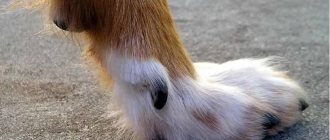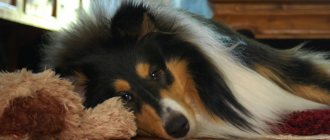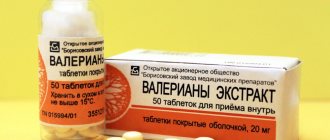- Posted by Olesya Vakhraneva
- Date: November 29, 2018
In cats, even completely healthy ones, stool disorders can occur due to a violation of the ratio of the types of intestinal microflora. The same problem, only more pronounced, can occur after completing a course of antibacterial therapy or when introducing new foods into the diet. The food supplement Fortiflora will help solve the problem of “low blood loss”.
- 2 Mechanism of action of Fortiflora
- 3 Indications for use
- 4 How to use Fortiflora correctly
4.1 Features of use in kittens and pregnant cats
Composition and release form of Fortiflora
Fortiflora is a probiotic dietary supplement developed by Purina. It is a light brown powder with light single grains, packaged in paper sachet bags, lined with foil on the inside, 1 g each. Sachet bags are packed in 30 pieces in cardboard packs. Fortiflora contains bacteria necessary for maintaining health, which have a number of beneficial qualities:
- prevent the development of pathogenic microbial flora on the intestinal mucosa;
- promote the absorption of nutrients from food;
- participate in the neutralization of substances such as bacterial toxins;
- heavy metal salts;
- allergens;
- antibacterial drugs;
Each single dose of Fortiflora is placed in a sachet; cardboard packaging contains 30 sachets
Composition of Fortiflora:
- live microencapsulated microorganisms Enterococcus faecium SF68 - minimum 1x108 CFU/g;
- proteins - 45%;
- fats - 15%;
- fiber - 0.5%;
- vitamin E - 5000 mg/kg;
- vitamin C - 3500 mg/kg;
- taurine - 2500 mg/kg;
- metabolic energy 3.1 kcal/g.
Fortiflora ingredients:
- Digest of animal origin - made from hydrolyzed tissue of animal origin; contains enzymes that improve digestion;
- Enterococcus faecium SF68 is the main component of the dietary supplement; probiotic bacteria;
- vitamin C is a strong antioxidant; strengthens connective tissue and vascular walls; inactivates cell-damaging free radicals;
- vitamin E - has an antioxidant and anti-inflammatory effect; accelerates the formation of T-lymphocytes; improves the function of the sex glands;
- beta-carotene - vitamin A; improves the condition of the skin and mucous membranes, has a positive effect on vision, and promotes the restoration of damaged tissues;
- zinc proteinate - necessary for the synthesis of insulin, proteins and the absorption of vitamin A; formation of lymphocytes;
- taurine is an essential amino acid that improves blood supply and metabolism in muscle tissue, including the heart muscle; regulates blood levels of antioxidant vitamins C and E; needed for the formation of bile;
- manganese proteinate - also participates in the synthesis of insulin, as well as the absorption of vitamins A, B, C, E;
- ferrous sulfate - provides iron for building hemoglobin molecules;
- Copper proteinate - has a positive effect on coat color and reproductive system;
- calcium iodate - a source of iodine to improve the functioning of the thyroid gland;
- sodium selenite - serves as a source of selenium, acts as an antioxidant; prevents the development of cardiomyopathy caused by selenium deficiency in young animals.
Fortiflora is added to the food consumed; Thanks to its pleasant taste and smell, cats eat it with pleasure
Indications for use
According to the instructions for use, Lactobifadol is suitable for use in various cases when there is a need to maintain a healthy balance of intestinal microflora:
- to normalize digestion and appetite, maintain normal microbiocenosis (qualitative and quantitative composition of microorganisms) of the gastrointestinal tract, including in the postoperative period;
- for the treatment and prevention of constipation/diarrhea of various etiologies;
- to normalize metabolic processes, the condition of the skin and coat, strengthen the immune system, including in preparation for competitions or exhibitions;
- for viral infections to prevent bacterial complications;
- in the treatment of diseases of the skin, joints, gastrointestinal tract, liver, kidneys as an additional remedy;
- during pregnancy of a cat for the birth of healthy offspring and after birth to maintain lactation;
- bottle-fed kittens up to 30 days old for the prevention or treatment of dysbacteriosis;
- after poisoning, antibiotic therapy, a course of hormonal drugs, deworming, taking hormonal, antihistamine, antitumor and other drugs;
- with a tendency to frequent diseases in animals of different ages.
How to use Fortiflora correctly
The product is very convenient to use - the contents of the bag are poured into the cat's food; The usual dose is 1 g (1 sachet packet) of the product once a day. Cats like the taste and smell of the drug, and they willingly eat the nutritional supplement. Can be added to both dry and wet food. The dose of the product does not change depending on the age, weight and size of the pet. The course of administration can be unlimited, usually based on the prescription of a veterinarian.
Features of use in kittens and pregnant cats
Due to its safe composition, Fortiflora is used both in kittens and pregnant cats. Fortiflora is especially useful for bottle-fed kittens, since they do not receive the necessary bacterial flora from the mother cat to populate the intestines and ensure their proper functioning.
Instructions for use
You can hear a lot of good reviews about FortiFlora, but taking a probiotic will only give positive results if you use it correctly. So, according to the official annotation, it is recommended for a cat to take 1 sachet per day, the contents of which should be poured onto the food, and it should not be hot, otherwise the living bacteria will die. At the discretion of the veterinarian, the daily dosage can be divided into several times.
It is necessary to add a probiotic to your cat's food immediately before meals.
Usually, FortiFlora is used until the symptoms completely disappear, so the duration of the treatment course is determined for each pet individually. If the owners give their four-legged pet a nutritional supplement in order to prevent a state of increased stress, for example, when moving, then it is advisable to start taking it a few days before the upcoming event and continue it 48-72 hours later.
Table: comparison of Fortiflor and its analogues
| Name | Compound | Indications | Contraindications | Price |
| Fortiflora | Enterococcus faecium; proteins, fats, fiber, vitamins C and E, taurine | Intestinal dysbacteriosis; violation of the consistency of feces in kittens; as part of the treatment of pathology of the digestive system; diarrhea caused by poor diet, taking antibacterial drugs or stress | Individual hypersensitivity to the components included in the composition | 1460 for 30 sachets (1 sachet per day) |
| Lactobifid | Lyophilisate of cultures of lactobacilli, bifidobacteria, streptococci; powdered milk, lactose | During periods of increased stress on the body - during stress, decreased immunity, after taking antibacterial drugs, previous infectious diseases, surgical interventions, vaccinations; when changing the type of diet; during pregnancy, as well as after childbirth; to improve the elimination of toxins in liver failure; during the recovery period after severe blood loss, burns | Individual hypersensitivity to the components included in the composition | 88 for 20 tablets (one tablet per day) |
| Prokolin | Enterococcus faecium, fructooligosaccharides, acacia extract, pectin, dextrose, kaolin, soybean oil | For acute poisoning, infectious diseases, antibacterial therapy, helminthiasis, stool disorders due to stress or changes in diet | Individual hypersensitivity to the components included in the composition | 800–1000 per 30 ml (1–2 ml per day) |
Contraindications and side effects
Since this food additive contains only natural ingredients, it can be given to very young kittens, older cats, pregnant and lactating cats. A contraindication for use can only be a pet’s allergy to any component of the medication. If such intolerance is observed, side effects are possible in the form of rashes on the surface of the skin, itching, and sometimes diarrhea, but these are extremely rare phenomena. Overdose is excluded, since 1 packet of the drug is used for each dose, which is very convenient for the owner.
Often, in an animal that has suffered a serious illness, taken antibiotics, the microflora of the digestive system is disrupted, as a result of which the pet becomes lethargic, loses appetite, the hair becomes dull and falls out, the dog or kitten simply withers before our eyes. The instructions for using Fortiflora for cats claim that after a course of this supplement, such problems will disappear.
Contraindications and side effects
It is impossible to harm a pet with a probiotic, except in cases where it has an individual intolerance to the components of the drug. If your animal has previously had allergic reactions, it is better to ask a specialist about the advisability of the supplement. In all other options, it will be tasty and healthy for your pet.
Important! Constant dry food in a cat's diet threatens the development of diabetes mellitus, dysfunction of the kidneys and digestive organs, urolithiasis, obesity and tartar. Experts equate such food to “fast food” and do not recommend it for regular consumption.
general characteristics
The drug is available in powder form, intended to be added directly to food (dry or wet). The powder is also suitable for mixing with natural foods and dairy drinks. It has a pleasant meaty taste, so dogs eat it with pleasure.
Fortiflora promotes the formation of beneficial intestinal microbiota and can be used for both preventive and therapeutic purposes in cases of disruption of the gastrointestinal tract.
The probiotic included in the composition is protected by a special shell, which prevents the destruction of bacteria in the stomach and allows them to maintain their viability.
Pros and cons of Fortiflora:
in addition to the probiotic, it additionally contains vitamins and minerals;
has a convenient release form;
has a wide spectrum of action;
improves immunity and helps absorb vitamins;
helps normalize digestion and stool;
improves the condition of the skin and coat;
reduces allergy symptoms;
allowed for long-term use without the risk of side effects;
can be used for puppies, pregnant and lactating bitches;
has no contraindications.
high price.
How to properly give probiotics to adult cats and kittens
Regardless of the age or weight of the animal, the daily dose is 1 g - 1 sachet.
The duration of use depends on the complexity of the disease, but most often veterinarians recommend continuing the course for 10 days.
Mode of application
Some owners mix the probiotic with their usual food or even buy another wet food. But in reality there is no such need - just sprinkle the powder on regular cat food.
When Donut (my sister’s cat) developed dysbiosis after using antibiotics, he was prescribed many different drugs, including Fortiflora. The vet advised giving the probiotic for a week. The packaging seemed expensive to us, so we bought 7 bags. These sachets do not have a cut for easy opening, so our bag broke. The powder spilled right into the cat's bowl. He knew that his favorite food was in the dish, so he started eating almost immediately (he never noticed the catch, although he was squeamish about foreign odors).
Most cats eat the supplement with pleasure, so there will be no problems with its use.
Application and dosage
According to the instructions from the manufacturer, the drug can be used in the presence of indigestion, diagnoses of dysbacteriosis or gastroenteritis, and a number of other pathologies. In practice, feed additives are often combined with medications when the pet has acute diseases of the digestive tract. The product is also used when changing food, weaning kittens from their mother, transporting a pet, leaving the owner, visiting a veterinary clinic, participating in competitions, or the arrival of guests, which can become stressful and negatively affect intestinal function.
To give the product to an animal, you need to pour the contents of the sachet into the food and mix. Only the dish cannot be subjected to heat treatment, this can lead to the death of living bacteria in its composition. Usually the drug is given once a day. The dosage, regardless of the age and weight of the pet, is 1 sachet. For a kitten, you can divide the contents into a couple of steps, but this is not a prerequisite.
The duration of treatment is determined individually, the course of treatment should last until the symptoms disappear, most often about 1 month. If prophylaxis is carried out, it is recommended to give the drug a few days before the planned event and continue for a couple of days after it.











